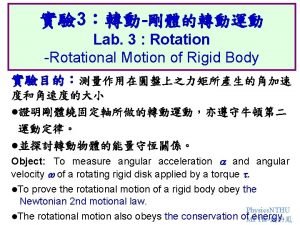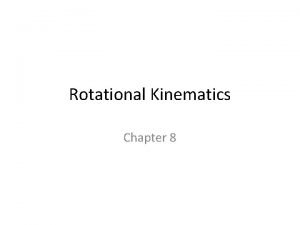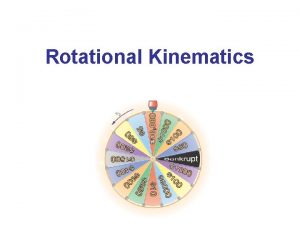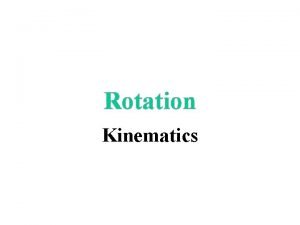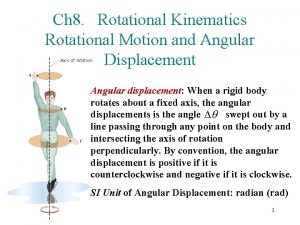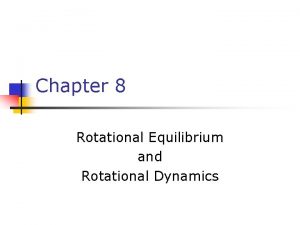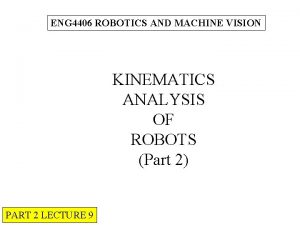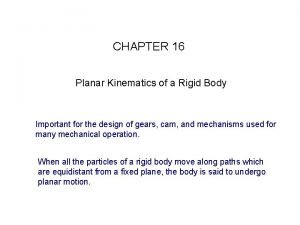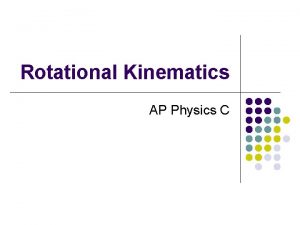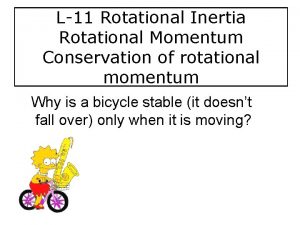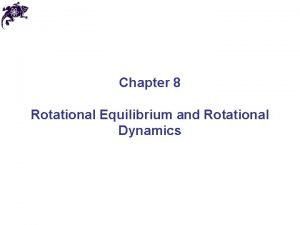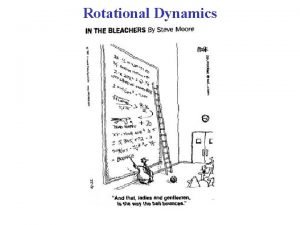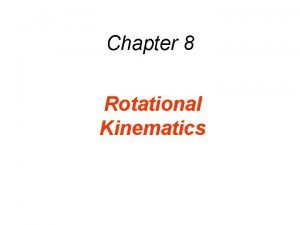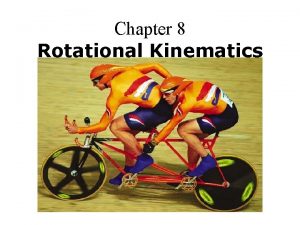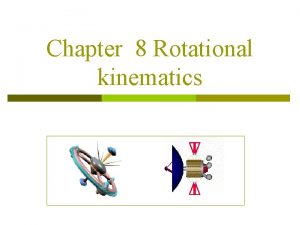Aim How do we explain rotational kinematics Are










- Slides: 10

Aim: How do we explain rotational kinematics?

Are angular quantities vectors? Yes, but there are only two directions that are possible: clockwise and counterclockwise

Which object moves with a constant nonzero angular acceleration? a) b) c) d) ω=3 ω=4 t 2 +2 t-6 ω=3 t-4 ω=5 t 2 -4 We take the derivative of each choice to find α. Choice c is the only derivative which provides a nonzero constant.

Distances How does the distance the center of mass of a car moves compare to the distance that the wheel travels? Same distance

Thought Question 1 The graph below shows how the angular velocity of a rotating disk varies with time. a) Rank the tangential accelerations of a point on the rim for moments a, b, c, and d. (Greatest to Least) (Assume positive values are greater than zero which are greater than negative values) A>B=D>C since at=rα b)Rank the centripetal accelerations of a point on the rim for moments a, b, c, and d. (Greatest to least) B>A=C>D since ac=rω2

Thought Question 2 A cockroach is on a rotating platform (like a merry go round). It spins in a counterclockwise direction with decreasing speed. At this moment, a) What is the direction of the cockroach’s tangential acceleration? Upwards b) What is the direction of the cockroach’s centripetal acceleration? To the right

Problem 1 -Rotational Variables What is the angular speed of (a) the second hand, (b) the minute hand, and (c) the hour hand of a smoothly running analog watch? Answer in radians per second. a) ω=2π/60 b) ω=2π/3600 c) ω=2π/43, 200

Problem 2 -Rotation with constant angular acceleration A disk, initially rotating at 120 rad/s, is slowed down with a constant angular acceleration of magnitude 4 rad/s 2. a) How much time does the disk take to stop? b) Through what angle does the disk rotate during that time? a) ωf=ωi+αt 0=120+(-4)t t= 30 s b) θ=ωit+1/2αt 2 Θ=120(30)+1/2(-4)(30)2=1800 rad

Problem 3 -Relating the Linear and Angular Variables A gyroscope flywheel of radius 2. 83 cm is accelerated from rest at 14. 2 rad/s 2 until its angular speed is 2760 rev/min. a) What is the tangential acceleration of a point on the rim of the flywheel during this spin up process? b) What is the centripetal acceleration of this point when the flywheel is spinning at full speed? C) Through what distance does a point on the rim moving during the spin-up? ω=2760 rev/min=2760(2π/60)=289 rad/s a) at=rα=0. 0283(14. 2)=0. 4 m/s 2 b) ac=rω2=0. 0283(289)2=2. 4 m/s 2 c) ωf 2=ωi 2+2αθ 2892=02+2(14. 2)θ Θ=2, 940 rad So d=rθ=0. 0283(2, 940)=83 m

Problem 4 -Relating the Linear and Angular Variables An astronaut is being tested in a centrifuge. The centrifuge has a radius of 10 m and in starting rotates according to θ=0. 3 t 2, where t is in seconds and θ is in radians. When t =5. 0 s, what are the magnitudes of the astronaut’s (a) angular velocity, (b) linear velocity, © tangential acceleration, and (d) centripetal acceleration a) ω=dθ/dt=0. 6 t ω=0. 6(5)=3 rad/s b) v=rω=10(3)=30 m/s c) α=dω/dt=0. 6 rad/s 2 at=rα=10(0. 6)=6 m/s 2 d) ac=rω2=10(3)2=90 m/s 2


